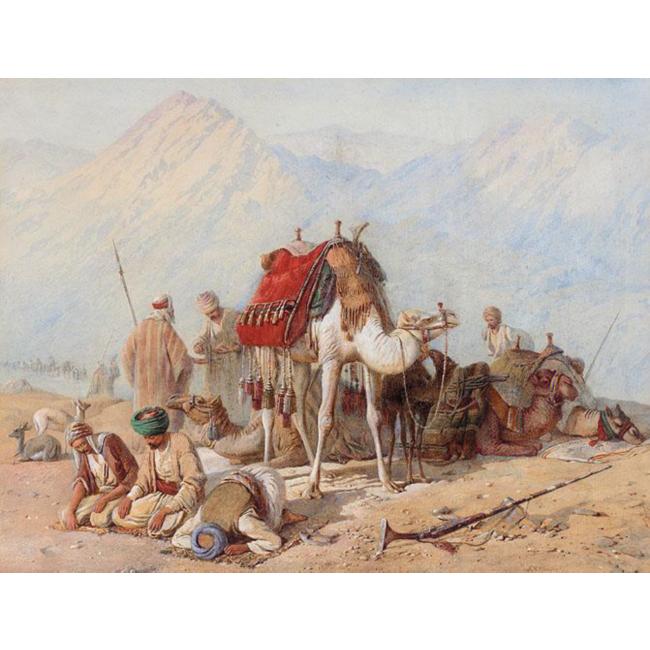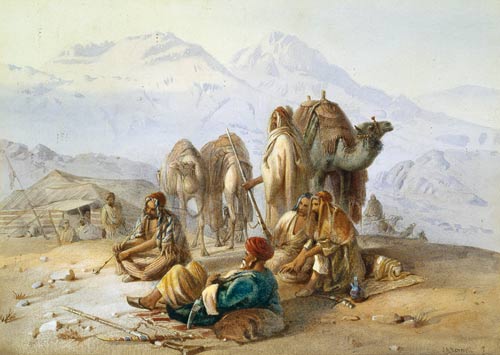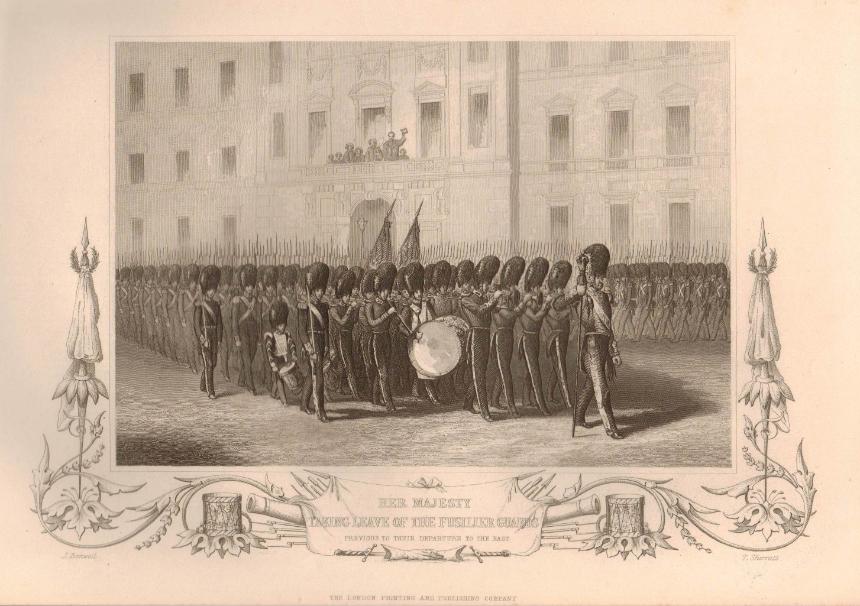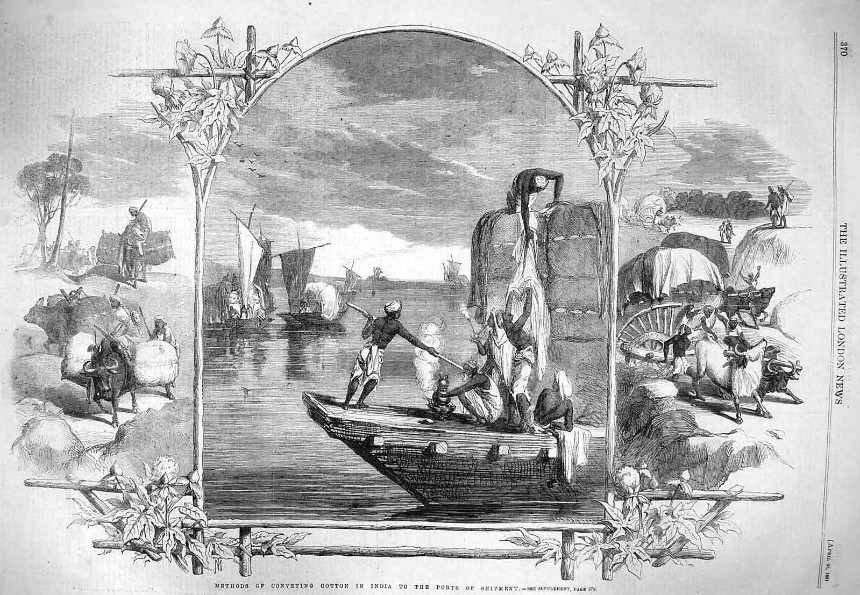Please Note- this website is best viewed on a desktop/laptop as it is not mobile-friendly. I am working on trying to convert it!
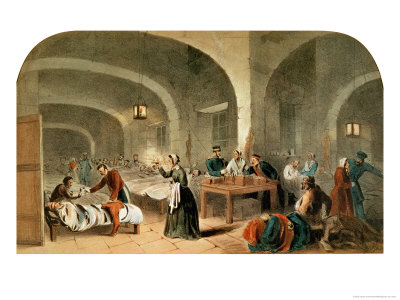
'Sketch of a ward at the hospital at Scutari' c1855

'The Heights of Alma - The Day After the Battle' 1854
Joseph Austin Benwell was an artist whose work was surprisingly varied, ranging from black and white engravings and woodcut illustrations for books and journals in the earlier part of his career, to coloured lithographs and later still, large watercolour paintings. His subject matter was mainly scenes from India and the Near and Middle East, his engravings of scenes depicting life in India in early and mid-Victorian times being particularly well-regarded. His output was really quite prolific from the early 1850s through to the early 1880s. More detail is given in each of the sections below.
Two of his earlier works are coloured lithographs featuring scenes from the Crimean War (1853-56). His 'Sketch of a Ward at the Hospital at Scutari' c1855, signed J A Benwell lower right, depicts Florence Nightingale as the lady with the lamp, in an iconic image often seen at exhibitions today. Ulrich Keller, in his book ‘The Ultimate Spectacle: A Visual History of the Crimean War’ (Routledge, 2002) states ‘If most Crimean hospital depictions spoke a decidedly romantic idiom, it must be emphasized in conclusion that one lithograph does seem to qualify as a reliable eyewitness account of the situation in the wards of Barracks Hospital. The artist of this undated but clearly contemporary print is the domestic artist J A Benwell, who must have made use of a fairly precise amateur drawing from Scutari. ……. - Benwell’s emphasis is indeed on organization, administration, professional service, and to this extent Nightingale’s work at Scutari did find at least one pictorial chronicler, after all.” Please refer to Miscellaneous and travel artwork for more detail.
Lesser-known is the battle scene shown in 'The Heights of Alma, the Day after the Battle' (1854). The Battle of Alma, considered to be the first battle of the Crimean War, took place just south of the River Alma in the Crimea.on 20 September 1854. It is possible that Joseph Austin Benwell was an eye-witness to these scenes as he was travelling back to India at the time. Another of his Crimean War works was the print 'Her Majesty taking leave of the Fusilier Guards previous to their departure to the East' which was published in ‘The History of the Present War with Russia’ by Henry Tyrrell, 1858.
It was after his return to London from India that he produced a prolific number of engravings and illustrations that were reproduced in various journals published by the Religious Tract Society, for example 'The Sunday at Home; a Family Magazine for Sabbath Reading' which include many illustrations by him during the years 1856 to 1870. His entry in the Modern English Biography ( Vol IV c.373, Frederic Boase, publ. Frank Cass & Co Ltd 1892, 1908, 1965) states that he '...executed thousands of wood blocks for the Religious Tract Society to about 1876, and in Missionary publications; illustrated The Illustrated London News and Sunday at Home for many years...'. Most of his engravings for the Illustrated London News during this period featured scenes from India.
In the early 1860s, Benwell experimented with hand painting 'dissolving views' on glass transparencies, projected onto a screen such that one view appears to pass into another. Benwell painted several series which were used to accompany lectures and exhibitions, such as those at the Royal Polytechnic Institution in London in 1862.
Later in his life Joseph Austin Benwell concentrated mainly on watercolour and gouache paintings in the style of the Orientalist art movement, featuring Middle-Eastern scenes. Most of his works in this genre were painted from around 1865 until close to his death in 1886. It was during this period that he exhibited most widely, at institutions including The Royal Academy in London and galleries around Britain. Quite a few of his paintings were exhibited at the Royal Society of British Artists, and are listed in ‘Works Exhibited at the Royal Society of British Artists, 1824-1893 and the New English Art Club, 1888-1917’ (J Johnson, Antique Collectors’ Club, 1975).
Generally speaking, Joseph Austin Benwell's varied artworks can be categorised into three main genres:
Orientalist Paintings -The Orientalist art movement
Western artists who travelled through the Near and Middle East from the start of the nineteenth century, painting their experiences as they travelled to countries such as Turkey, Persia, Iraq, Egypt, Lebanon, Palestine, Arabia. For example, pictures below left 'Arabs praying in the desert' and 'An Arab Encampment'.
Including illustrators and engravers in Victorian times who recorded scenes on every-day life in the far-flung empire, informing readers of publications such as the Illustrated London News. Some of these images can appear rather quaint and quirky to modern eyes, which adds to their appeal. Benwell illustrated two books about India published in the early 1850s, including 'The Three Presidencies of India' by John Capper, 1853, and 'Our Indian Army: A Military History of the British Empire in the East'' by Captain Rafter, 1855. He also produced engravings for the journal 'The Leisure Hour: A Family Journal of Instruction and Recreation' on the theme of India, for example the pictures below upper right from 'Indian Experiences in 1857-58' (The Indian Mutiny) from 'The Leisure Hour' 1862.
Victorian Religious Publications
Such as those published by the Religious Tract Society, with their paternalistic, benevolent and evangelical missionary quality, often seeming somewhat old-fashioned when viewed from a 21st century perspective. For example, picture below lower right from 'The Sunday at Home, a Family Magazine for Sabbath Reading' 1857.
Also
Miscellaneous and travel artwork Composite and Montage engravings Benwell's 'Dissolving Views'
Please click on each link above, or the pictures below, for more about each category.
Scenes from India (including the British in India)
' Escape of some of the Europeans from Bareilly' (1857-58, The Indian Mutiny)
'Her Majesty taking leave of the Fusilier Guards previous to their departure to the East'
(steel engraving) from The History of the War with Russia, 1858 by Henry Tyrrell
Benwell also specialised in making montages of some of his works. Several are shown on the page below.
You may like to check out the following pages if you are interested in matters of research, provenance or art-sleuthing in general!
Joseph Austin Benwell, William James Müller and ‘Prayers in the Desert’
'Desert Travellers'- An Enigma?
Art Research - other Bristol artists and miscellaneous
Orientalist Paintings including sections on research/auction catalogues, old newspapers etc.
Material researched and written by Dee Murray. Website compiled by Dee Murray. All rights reserved.
All images on this website are either scanned or photographed from the author’s own resources, or are in the public domain in digital format via websites such as HathiTrust, Openlibrary.org, the Internet Archive (archive.org) or Google Books.
